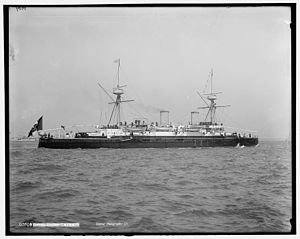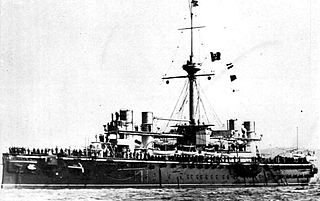
Lepanto was an Italian ironclad battleship built for the Italian Regia Marina, the second and last ship of the Italia class. Lepanto was laid down in November 1876, launched in March 1883, and completed in August 1887. She was armed with a main battery of four 432 mm (17 in) guns mounted in a central barbette and was capable of a top speed of 17.8 knots. Unlike other capital ships of the era, Lepanto had an armored deck rather than the more typical belt armor.

Giovanni Bausan was a protected cruiser of the Italian Regia Marina that was designed and built by Sir W G Armstrong Mitchell & Co.'s Elswick Works in England in the mid-1880s. The finished ship entered service in May 1885. She was the first ship of this type to be built for the Italian fleet, and she provided the basis for subsequent designs built in Italy, including the Etna class. Giovanni Bausan was intended to serve as a "battleship destroyer", and was armed with a main battery of two 10-inch (254 mm) guns to give her the ability to defeat heavy armor, but design flaws rendered her unfit for this role.

Umbria was a protected cruiser of the Italian Regia Marina built in the 1890s. She was the lead ship of the Regioni class, which included five other vessels. All of the ships were named for current or former regions of Italy. The ship was equipped with a main armament of four 15 cm (5.9 in) and six 12 cm (4.7 in) guns, and she could steam at a speed of 18 knots. Umbria spent much of her career abroad, including several years in American waters. In service during a period of relative peace, Umbria never saw combat. In 1911, she was sold to Haiti and renamed Consul Gostrück, though she did not serve for very long under the Haitian flag. Her crew was too inexperienced to operate the ship, and she foundered shortly after being transferred to the Haitian Navy.

Lombardia was a protected cruiser of the Italian Regia Marina built in the 1890s. The ship was the second of six vessels in its class, but was the first to enter service. Named for the region of Lombardy, she was laid down in November 1889, was launched in July 1890, and was completed in February 1893. The ship was equipped with a main armament of four 15 cm (5.9 in) and six 12 cm (4.7 in) guns, and she could steam at a speed of 18 knots.
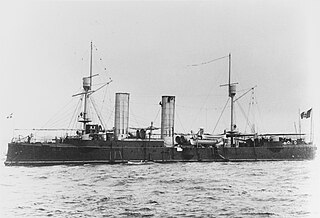
Dogali was a unique protected cruiser built for the Italian Regia Marina in the 1880s. Notably, she was the first warship equipped with triple-expansion engines. The ship was originally ordered by the Greek Navy and named Salamis, but she was sold to the Regia Marina before she was completed and renamed for the Battle of Dogali. She was armed with a main battery of six 15-centimeter (5.9 in) guns and reached a speed of 19.66 knots on her sea trials, making her one of the fastest cruisers at the time.

Stromboli was a protected cruiser of the Italian Regia Marina built in the 1880s. She was the second member of the Etna class, which included three sister ships. She was named for the volcanic island of Stromboli, and was armed with a main battery of two 254 mm (10 in) and a secondary battery of six 152 mm (6 in) guns, and could steam at a speed of around 17 knots. Her career was relatively uneventful; the only significant action in which she took part was the campaign against the Boxer Uprising in China in 1900. She returned to Italy in 1901 and spent the rest of her career in reserve or as an ammunition ship, apart from a brief stint in active service in 1904. Stromboli was stricken from the naval register in 1907 and sold for scrapping in 1911.

Vesuvio was a protected cruiser of the Italian Regia Marina built in the 1880s. She was the third member of the Etna class, which included three sister ships. Named for the volcano Mount Vesuvius, the ship's keel was laid down in July 1883. She was launched in March 1886 and was commissioned into the fleet in March 1888. She was armed with a main battery of two 254 mm (10 in) and a secondary battery of six 152 mm (6 in) guns, and could steam at a speed of around 17 knots. Her career was relatively uneventful; the only significant action in which she took part was the campaign against the Boxer Uprising in China in 1900. She was stricken from the naval register in May 1911 and sold for scrap in 1915.
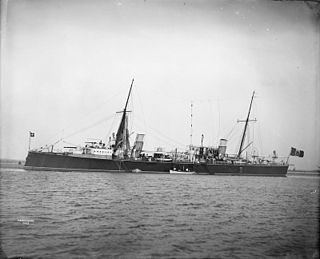
Partenope was a torpedo cruiser built for the Italian Regia Marina in the 1880s, the lead ship of her class, which included seven other vessels. The ship was built by the Regio Cantiere di Castellammare di Stabia; she was laid down in June 1888, was launched in December 1889, and was completed in September 1890. Her main armament were her five torpedo tubes, which were supported by a battery of ten small-caliber guns.

Euridice was a torpedo cruiser of the Partenope class built for the Italian Regia Marina in the 1880s. She was built by the Regio Cantiere di Castellammare di Stabia shipyard, with her keel laying in February 1889, her launching in September 1890, and her commissioning in May 1891. Her main armament was her six torpedo tubes, which were supported by a battery of ten small-caliber guns. Euridice spent most of her career in the main Italian fleet, where she was primarily occupied with training exercises. She was withdrawn from service in 1907 and sold for scrapping.

Urania was a torpedo cruiser of the Partenope class built for the Italian Regia Marina in the 1880s. She was built by the Cantieri navali Odero shipyard; her keel was laid in February 1889, she was launched in June 1891, and was commissioned in July 1893. Her main armament were her six torpedo tubes, which were supported by a battery of ten small-caliber guns. Urania spent most of her career in the main Italian fleet, where she was primarily occupied with training exercises. She was still in service at the outbreak of the Italo-Turkish War in September 1911, but she did not take part in any operations. Instead, she remained in Italian waters and was broken up for scrap in January 1912.

Iride was a torpedo cruiser of the Partenope class built for the Italian Regia Marina in the 1880s. Laid down in February 1889 at the Regio Cantiere di Castellammare di Stabia shipyard, she was launched in July 1890 and was commissioned in November 1892. Her main armament were her six torpedo tubes, which were supported by a battery of ten small-caliber guns. Iride spent most of her career in the main Italian fleet, where she was primarily occupied with training exercises. During the Italo-Turkish War in September 1911, she remained in Italian waters until late in the conflict; she escorted a troop convoy to North Africa in April 1912 and bombarded Ottoman positions in June and July. Iride was eventually broken up for scrap in December 1920.

Caprera was a torpedo cruiser of the Partenope class built for the Italian Regia Marina in the 1880s. She was built by the Cantiere navale fratelli Orlando shipyard; her keel was laid in July 1891, she was launched in May 1894, and was commissioned in December 1895. Her main armament were her five torpedo tubes, which were supported by a battery of eleven small-caliber guns. Caprera spent most of her career in the main Italian fleet, where she was primarily occupied with training exercises. She served in the Red Sea during the Italo-Turkish War of 1911–1912, where she conducted shore bombardments and blockaded Ottoman ports in the area. Caprera did not remain in service long after the war, being sold for scrap in May 1913.

Calatafimi was a torpedo cruiser of the Partenope class built for the Italian Regia Marina in the 1880s. She was built by the Cantiere navale fratelli Orlando shipyard; her keel was laid in July 1891, she was launched in May 1894, and was commissioned in December 1895. Her main armament were her five torpedo tubes, which were supported by a battery of eleven small-caliber guns. Calatafimi spent most of her career in the main Italian fleet, where she was primarily occupied with training exercises. The ship was sold in March 1907 and broken up for scrap.

Saetta was a Folgore-class torpedo cruiser built for the Italian Regia Marina in the 1880s. Armed with three 14 in (356 mm) torpedo tubes and six light guns, she was capable of a top speed of 17 knots. She was built in the mid-1880s, was launched in May 1887, and was completed in February 1888. Saetta spent the first decade of her career serving in the main Italian fleet, where she conducted peacetime training exercises. In 1897, she was withdrawn from front-line service and employed as a gunnery training ship, a role she filled for another decade. The Regia Marina ultimately sold Saetta for scrap in May 1908.

Goito was a torpedo cruiser built for the Italian Regia Marina in the 1880s. She was the lead ship of the Goito class, which included three other vessels. Goito was built by the Regio Cantiere di Castellammare di Stabia shipyard between September 1885 and February 1888. She was armed with a variety of light guns and five 14-inch (356 mm) torpedo tubes, and was capable of a top speed of 18 knots. The ship served the duration of her career in the main Italian fleet. Her early service was primarily occupied with training exercises; front-line duties ended in 1897 when she was converted into a minelayer, though she continued to participate in fleet exercises. During World War I, Goito laid defensive minefields in the Adriatic Sea. She was eventually sold for scrap in 1920 and broken up.

Montebello was the second of four Goito-class torpedo cruisers built for the Italian Regia Marina in the 1880s. She was built at the Arsenale di La Spezia between September 1885 and January 1889, when she entered service. She was armed with a variety of light guns and four 14-inch (356 mm) torpedo tubes, and was capable of a top speed of 18 knots. Montebello spent her active-duty career with the main Italian fleet, where she frequently took part in annual training exercises. In 1903, she was withdrawn from front-line service and converted into a training ship for engine room personnel; she served in this capacity until 1920, when she was sold for scrap.

Monzambano was a torpedo cruiser of the Goito class built for the Italian Regia Marina in the 1880s. The ship was built at the Arsenale di La Spezia, beginning with her keel laying in August 1885 and ending with her completion in August 1889. She was armed with a variety of light guns and five 14-inch (356 mm) torpedo tubes, and was capable of a top speed of 18 knots. The ship spent her career in the main Italian fleet conducting training exercises, and did not see action. She spent 1898 patrolling the eastern Mediterranean Sea with the Levant Squadron. Monzambano was withdrawn from service in 1901 and broken up for scrap that year.

The Folgore class was a pair of torpedo cruisers built for the Italian Regia Marina in the 1880s. The two ships—Folgore and Saetta—were designed by Benedetto Brin during a period of experimentation with the theories of the Jeune École in the 1880s. The vessels were armed with three 14 in (356 mm) torpedo tubes, and they had a top speed of 17 knots. Both ships' careers were uneventful, and they spent most of their time in service conducting training exercises. Folgore was seriously damaged in a collision in 1889, and was thereafter reduced to reserve status, as the damage could not be completely repaired. She was eventually sold for scrapping in 1900, while Saetta served as a gunnery training ship from 1897 to 1908, when she too was dismantled.
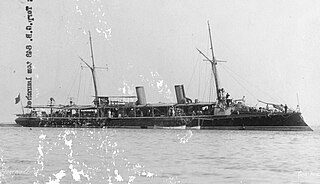
Tripoli was the first modern torpedo cruiser built for the Italian Regia Marina. She was built by the Regio Cantiere di Castellammare di Stabia shipyard in 1885–86. The only vessel of her class, she provided the basis for the Goito and Partenope classes that followed. She was armed with five 14-inch (356 mm) torpedo tubes and a battery of light guns, and was capable of a top speed of 17.5 knots. Tripoli spent her career in the main Italian fleet, where she was occupied primarily with peacetime training exercises. She was modernized several times throughout her career, and in 1910, was converted into a minelayer, a role she served in for another thirteen years, including during World War I. She was the longest serving torpedo cruiser in the Italian fleet, with over 36 years in service by the time she was discarded in March 1923.
